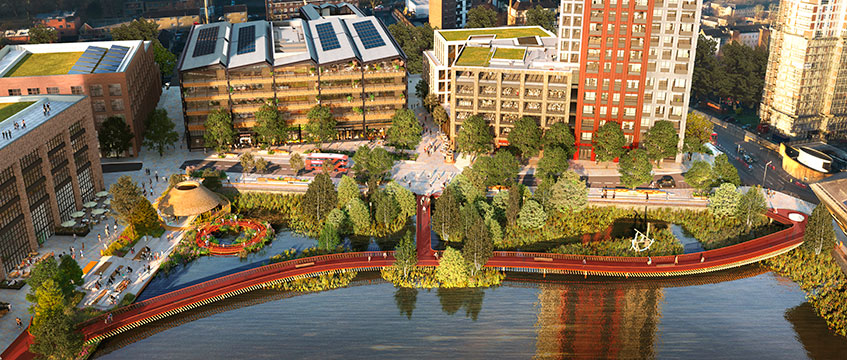British Land and AustralianSuper on the future of Canada Water
The mammoth £3.5bn-plus regeneration of Canada Water has been given a boost as British Land finally brings on board an Australian pension giant to form a joint venture.
The FTSE 100 REIT confirmed this morning that it has sold half of its stake in the 53-acre scheme to AustralianSuper for £290m in a deal that values British Land’s original holding at £580m, more than a fifth higher than its book value at the end of September.
Stifel analyst John Cahill has described the joint venture as a “good strategic decision” by British Land given that it will share out the risk of the scheme’s delivery and release capital for redeployment into the project itself.
The mammoth £3.5bn-plus regeneration of Canada Water has been given a boost as British Land finally brings on board an Australian pension giant to form a joint venture.
The FTSE 100 REIT confirmed this morning that it has sold half of its stake in the 53-acre scheme to AustralianSuper for £290m in a deal that values British Land’s original holding at £580m, more than a fifth higher than its book value at the end of September.
Stifel analyst John Cahill has described the joint venture as a “good strategic decision” by British Land given that it will share out the risk of the scheme’s delivery and release capital for redeployment into the project itself.
Cahill added that the partnership also “ought to reduce any investor anxiety over the scheme’s delivery given previous REIT difficulties realising large London schemes”, pointing to Capital & Counties at Earls Court and St Modwen at Nine Elms.
Hard graft
Don’t think this has been easy, however – today’s deal is just another, albeit significant, step in a decades-long project for British Land. “We have been busy assembling this site since 2009,” says Emma Cariaga, the REIT’s joint head of the development alongside Roger Madelin. “It is over a decade of graft in terms of putting it together.”
In another 10 years, Cariaga adds, “with a fair wind, no more pandemics, no economic cycles”, the company will have completed a new town centre for London and the capital’s “first net-zero neighbourhood”.
Work on phase 1 of the masterplan is underway on site and expected to complete in the third quarter of 2024, with the two parties committing £201m of funding to three buildings covering 582,000 sq ft and including 265 new homes. Future development will be funded through a mix of shareholder equity and third-party debt.
The first tenant on the campus moved in last year – TEDI-London, a higher education institute specialising in engineering and design, took possession of a 15,000 sq ft modular building including classrooms, breakout spaces and labs.
The outline planning permission gives scope for the development of between 2,000 and 4,000 homes – 3,000 is the working assumption, Cariaga says – and between 500,000 sq ft and 2.5m sq ft of workspace. “We can effectively choose, and that’s the nice thing about parameters-based outline planning permission – nobody really knows what the world is going to look like in five or 10 years’ time,” she adds.
The scheme marks British Land’s fourth campus and its first foray south of the River Thames. “This was very much a Crossrail play,” Cariaga says. “Pre-Covid, the Jubilee line, which serves Canada Water very well, had some capacity issues. But with Crossrail coming on stream and everybody, as and when it opens, switching lines to join that new line, Canada Water becomes quite important.”
Committed to the UK
For AustralianSuper, the deal is a statement of intent as the pension fund looks to bolster its investments in the UK. Paul Clark, the fund’s senior investment director for property in the UK, says that as the team looks to grow members’ funds to A$500bn (£280bn) from roughly A$260bn now, he would expect investment in the UK to double in line to around £15bn.
“We have a couple of things in our favour,” he says. “We can do scale and we’ve got time because the average age of an AustralianSuper member is a little over 40. And only about 3% of our members are in retirement now. So we can look for the sort of Canada Water transaction where we get the opportunity to work in a more rarefied atmosphere – there are not that many people that can take on this scale of commitment and also have the time to deliver it.”
Creative investment
There are two areas of focus for the fund in Europe, Clark says. One is mixed-use city centre development at scale, with London remaining a favoured pick as well as cities including Berlin, Paris, Amsterdam and Stockholm. And then there is logistics, where the fund is eager to make a mark. “But I don’t want to stand in a queue of 12 for the latest batch of tightly priced standing assets in the stronger markets,” Clark says. “We will look to be more creative if we come into that sector.”
Deals such as Canada Water will be few and far between, he adds – there simply aren’t that many projects that look to deliver what the London scheme proposes. All the more reason to jump on them when they become available.
“For large-scale urban regeneration projects, you need three things to come together,” Clark says. “Location – [Canada Water is] at the confluence of the Underground and the Overground. Scale – at 53 acres you control not just the architecture, but the space between the buildings and the placemaking element of it, which is critical. And quality – to get quality, you need two partners with the time and the money to do it.”
To send feedback, e-mail tim.burke@eg.co.uk or tweet @_tim_burke or @EGPropertyNews
Photo courtesy of FTI Consulting











